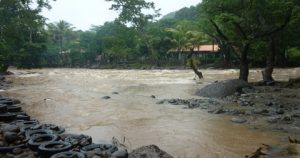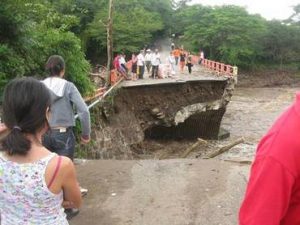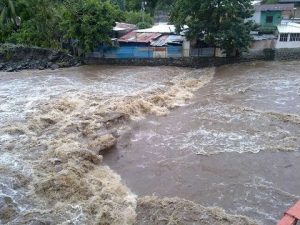Community Development Projects, Get Involved
El Salvador in a State of Emergency in the Wake of Tropical Storm Agatha
El Salvador has been in a state of emergency since Saturday May 29th. What started out as a surprisingly rainy day on Wednesday turned into five days of heavy rain, flooding and landslides that have left many parts of the country severely damaged. CRIPDES has been working full time to help evacuate and house families and assess the damages to homes, infrastructure and agriculture.
The most urgent need at the moment is for food and toiletries for both the displaced families and those who stayed in their homes only to see their crops and belongings be destroyed. Please send donations to Sister Cities at our Plattsburgh NY mailing address.
Below is a report from CRIPDES president Rosa Maria Centeno about the storm and a breakdown of how individual sister cities communities were effected.
ASOCIACIÓN PARA EL DESARROLLO DE EL SALVADOR, CRIPDES
Tel. (503) 22263717 /22354005 / cripdes@telesal.net
San Salvador, 31 de Mayo de 2010
Dear friends and partner organizations,
Thank you for being attentive to the emergency situation in El Salvador. Below is a preliminary report of the damage caused by the Tropical Storm Agatha.
Since May 25th 2010, the civil protection system has been following the development of Agatha, by elevating the alert levels according to the danger. On May 29th at 11:00 pm, a red alert, i.e. a national emergency, was declared for the whole country. This alert remained in place until 10:00 am on May 31st. The accumulation of rain has saturated the ground with water and the rivers and streams have overflowed. School has been suspended on a national level. Travel across the border of La Hachadura, between El Salvador and Guatemala, has been suspended because a bridge on the border has collapsed.
As of May 30th tropical storm Agatha was at its most critical point with rains across the entire territory of El Salvador causing substantial damages:
- People affected: 8717 people evacuated, 8119 people in 150 shelters, 9 deaths, 2 people disappeared, and 3 people injured.
- Infrastructure affected: 97 houses affected, 11 houses destroyed, 4 collapsed or damaged walls, 2 collapsed or damaged bridges, one school affected, and 15 health clinics affected.
- Natural Events: 14 floodings, 188 landslides, 27 fallen trees, 3 collapses, 9 fallen poles, 39 ditches.
Since Thursday May 27th, CRIPDES has been working with CRIPDES communities to help prepare for evacuations. In the CRIPDES regions there have been 1669 families evacuated, according to the following breakdown:
- Municipality of Tecoluca, San Vicente: Preventative evacuations of 35 families, which is a total of 214 people, 125 women and 89 men.
- Municipalities of the Port of La Libertad and Tamanique: 1609 families evacuated, totaling 3982 people. In the southern part of La Libertad many rivers have overflowed and caused flooding of houses.
- In the municipality of El Paisnal, 10 families whose houses were flooded by the overflowing River Lempa were evacuated.
- In the municipality of El Zapotal, in the department of Chalatenango, 15 families are in shelters.
Affected Infrastructure and Agriculture:
- The road that connects the municipality of Suchitoto in the department of Cuscaltan, and the municipalities of Tenancingo, Cinquera, and Tejutepeque in the department of Cabañas has no bus travel because the Queselapa River destroyed part of the road that had been built after Hurricane Ida. It will be necessary to build a new bridge.
- The Sumpul River bridge that connects the municipalities of Arcatao and Nueva Trinidad with San Jose Las Flores was heavily damaged and no vehicles can cross.
- The Lempa River destroyed 65 meters of the retaininglevy that retains the water of that river, near the community of Pacun in the municipality of Tecoluca, but fortunately the river didn’t rise enough to flood the communities. The communities of El Rancho and Taura have been preventatively evacuated.
- One of the biggest losses caused by the storm is the loss to farming communities where crops were already planted.
While Tropical Storm Agatha is mostly over, many rural communities are still without communication and the dangers of flooding, landslides and collapses still continue, because the effects of the rain will continue throughout the rainy season.
CRIPDES is accompanying the population in the areas where we work especially in the evacuation efforts and organization of shelters. We will continue to accompany the affected population so that this situation resolves itself. We hope that the government will assume responsibility in the reconstruction, as it has promised, and will also ensure that the population is in better condition to confront natural disasters in the future.
As soon as we have an evaluation of the damages, we will accompany the reconstruction process as well.
The population needs basic goods, hygiene kits and blankets and I hope that you can help us CRIPDES meet those needs.
Warm greetings,
Rosa María Centeno Valle
President of CRIPDES
The Effects of Storm Agatha on Sistered Communities
La Libertad
We visited El Charcon on May 30th and members of the Junta Directiva showed how high the water rose, a level which was much higher than they had ever seen before. Five families were evacuated from their homes while the homes of many others living on the border of the river were flooded with one or two feet of water. The road into El Charcon was slightly damaged but now cars can pass through. In Chilama, where most of the community lives only meters away from the river, almost all homes were flooded with belongings suffering various levels of water damage. In the community 10 families were most affected but the flooding was not so great that they had to evacuate.
Suchitoto Region
Like many communities. Cinquera has been isolated by the storm because the road that connects it to Suchitoto is severely damaged. Otherwise the main loss is that of the crops planted before the storm.
San Vicente
The sistered communities of Guajoyo and Las Anonas luckily did not flood but the Rio Aguacate, which runs alongside Las Anonas will be a risk for the rest of the rainy season. However, neighboring communities like Rancho Grande, Taura and Santa Marta were evacuated. The evacuated communities are expected to return tomorrow after a survey is made of the damages to their homes.



